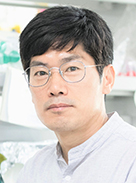
 |
김태수 (이화여자대학교)
Dr. TaeSoo Kim is a professor in the Department of Life Sciences at Ewha Womans University. He earned his Ph.D. in biological sciences from Seoul National University under the supervision of Dr. Hyen Sam Kang, before starting on a research journey in the Buratowski lab at Harvard Medical School. During his postdoctoral training in the Buratowski lab, Dr. Kim investigated the mechanisms governing the targeting of Set3 HDAC to transcribed genomic regions, leading to pivotal discoveries published in Cell in 2009. He further explored the functional interplay between this complex and overlapping non-coding RNA transcription, unraveling their profound impact on the kinetics of gene induction (2012 Cell). In 2013, Dr. Kim joined Ewha Womans University as an assistant professor. Since then, his research group has been dedicated to unraveling the intricate roles of chromatin regulators, including HDACs, and HATs in the control of gene expression dynamics and transcriptional memory. Their primary focus is understanding how these molecular players orchestrate cellular processes in response to environmental changes. One of the standout achievements of Dr. Kim's group is the discovery of Transcriptional Repression Memory (TREM), a novel transcriptional response that finely tunes the repression of genes not essential for cellular functions. This finding was published in NAR in 2018. Additionally, Dr. Kim's laboratory is deeply engrossed in understanding the intricate regulations governing non-coding RNA transcription from cryptic cis-regulatory elements within protein-coding sequences. Their work in this field has resulted in publications in renowned journals such as Nature Communications in 2016 and 2019, NAR in 2020 and 2021. Most recently, Dr. Kim's group identified a novel cryptic element hidden within open reading frames, shedding light on the production of a distinct set of non-coding RNAs. |